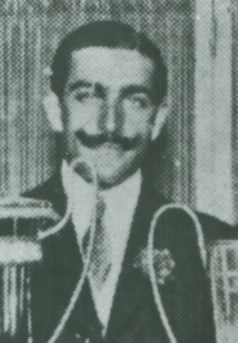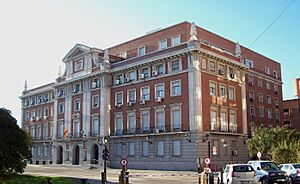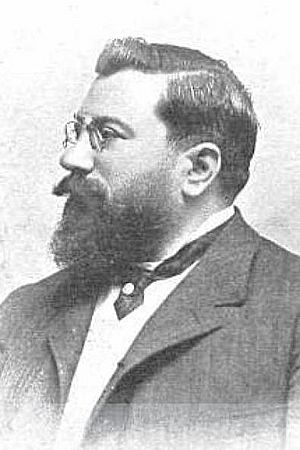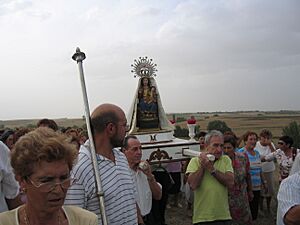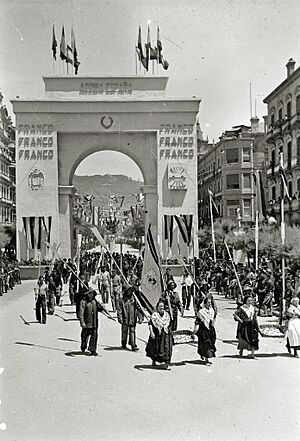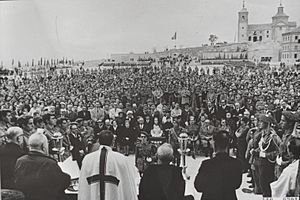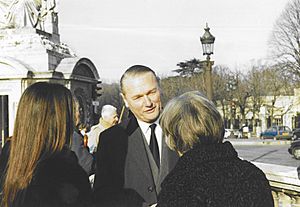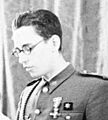Rafael Gambra Ciudad facts for kids
Quick facts for kids
Rafael Gambra Ciudad
|
|
|---|---|

Gambra in 1939
|
|
| Born | 21 July 1920 Madrid, Spain
|
| Died | 13 January 2004 (aged 83) Madrid, Spain
|
| Era | 20th-century philosophy |
| Region | Western philosophy
|
| School | |
|
Main interests
|
Political philosophy |
Rafael Gambra Ciudad (born July 21, 1920 – died January 13, 2004) was an important Spanish thinker, a government official in charge of schools, a Carlist politician, and a soldier. In philosophy, he is known as a key figure in late Traditionalism. His ideas also covered the theory of how states and governments work.
He is most famous for his books that talked about how Western European culture became less religious in the age of the "consumer society," where people focus a lot on buying things. As a politician, he was more of a thinker and writer than someone who actively led campaigns. However, for a short time after 2001, he did lead one of the Carlist groups.
Contents
Early Life and Family
Rafael Gambra grew up in a family with a long history in the Valle de Roncal region of Spain. His ancestors were known for fighting against the French in the Peninsular War in 1809. Rafael's grandfather, Pedro Francisco Gambra Barrena, held important positions in the Ministry of Economy.
Rafael's father, Eduardo Gambra Sanz (1878-1964), was an architect. He designed important buildings in Madrid, like the offices of Sociedad Gran Peña. In 1915, he married Rafaela Ciudad Villalón (died 1947). Her father, José Ciudad Aurioles, was a well-known civil servant who served as a senator and even as President of the Supreme Court. Rafael was their only child.
Rafael was born and raised in Madrid, but he spent many summers in Valle de Roncal. He loved his family's heritage from Navarre, a region in northern Spain. People often called him a "Navarro" (someone from Navarre) rather than a "Madrileño" (someone from Madrid).
His family was very Catholic. His father supported Carlism, a traditionalist political movement in Spain, and his mother also held conservative views. Rafael went to the Madrid Marianist Colegio del Pilar school. Even as a schoolboy, he loved reading books more than playing sports. He was also involved in a Catholic association called Asociación Católica Nacional de Propagandistas.
In July 1936, when Rafael was 16, his family was on holiday in Roncal. This was when the Spanish Civil War began. Rafael volunteered to join a Carlist military unit called the Requeté. He spent two years fighting on the front lines in the Sierra mountains. In 1939, he joined another unit and was decorated with many military awards after the Nationalist victory.
Rafael Gambra married María del Carmen Gutiérrez Sánchez (1921-1984). She was a translator, scholar, and writer of popular novels. They had three children. His two sons, Andrés Gambra Gutierrez and José Miguel Gambra Gutiérrez, both became scholars. They are also active in the Traditionalist movement, with José Miguel leading one of the Carlist groups since 2010.
Education and Teaching Career
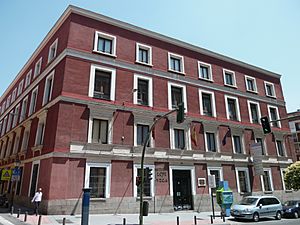
In 1939, Gambra began studying philosophy at Universidad Central. He graduated in 1942. A year later, he became a professor in national secondary schools. In 1945, he earned his PhD in Philosophy. His main research for his PhD was a critical review of the ideas of Karl Marx and Feuerbach. This work was published in 1946.
In the early 1940s, Gambra started teaching at the Madrid Academia Vazquez de Mella. This was a Carlist educational center where he lectured on Traditionalist ideas about philosophy, government, and politics. In 1943, he moved to Pamplona and became a philosophy professor at the Instituto Príncipe de Viana. He worked there for 12 years.
In the mid-1950s, he returned to Madrid. He taught at new "model centers" for secondary education, first at Instituto Miguel de Cervantes and then at Instituto Nacional de Enseñanza Media Lope de Vega, where he later became vice-director. As an education official, he wanted to protect "spirituality" in schools. He also worked with Universidad Complutense and the San Pablo CEU college until 1994.
Beyond his main job, Gambra also taught at other academic places. He gave lectures at Ateneo de Madrid and Instituto de Cultura Hispánica, an organization created by the Franco government to connect with Latin American countries. He also participated in various Catholic and scientific events.
In the mid-1960s, he became involved with the Madrid-based Centro de Estudios Históricos y Políticos General Zumalacárregui. This was a group that aimed to spread Traditionalist ideas and oppose more modern views within Carlism. By the late 1960s, he was seen as an important authority, especially among Traditionalists. He continued giving lectures into the 1980s and 1990s, celebrating 50 years of teaching in 1998.
Main Ideas and Philosophy
Rafael Gambra's ideas were largely inspired by Plato and especially St. Thomas Aquinas. He is sometimes called a "neo-scholastic" philosopher, meaning he followed a modern version of medieval Christian philosophy. His Christian views were also shaped by thinkers like Gustave Thibon, Etienne Gilson, and Romano Guardini. In politics, he followed the ideas of Alexis de Tocqueville and Juan Vázquez de Mella.
A main part of Gambra's thinking was rejecting a society based only on human reason (rationalism). Instead, he promoted a Traditionalist way of looking at the world. He believed that human life should be dedicated to a divine (God-given) order. He saw human identity as a mix of who you are as an individual and your connection to your community.
He thought that people are primarily social beings, not just independent individuals. Our role in society and our contribution to the common good are very important. He believed that a society needs a shared purpose and religious inspiration to be strong. He argued that a public organization not based on accepted religious beliefs could never be stable. Gambra supported a public embrace of religious doctrine, while still respecting people's private beliefs.
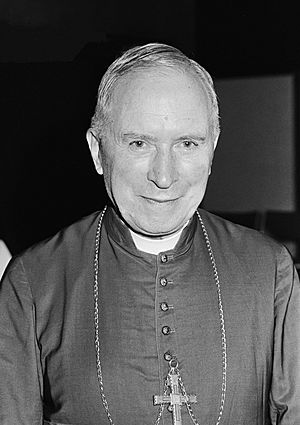
Gambra believed that a person's social self is best shown through tradition. He saw tradition as a long, continuous development that guides historical societies. He thought it was the opposite of revolutionary changes. For Spain, he believed tradition meant a hereditary monarchy (where the ruler inherits the throne) instead of elected leaders. It also meant a federal structure (where power is shared) instead of a single, central government.
He supported "organic representation," where different groups in society (like workers or farmers) are represented, rather than individual-focused democracy. He also believed in Catholic religious beliefs as the official standard, instead of a secular or neutral government. He thought that government structures should be less powerful, unlike the modern, very powerful state. Politically, he saw Carlism as the protector of this tradition, not just a political group, but the very heart of Spain's identity.
A key part of Gambra's ideas was his criticism of modern religious practices. He believed that some thinkers were turning Christianity into a "new humanist religion" that had given up the fight against secular changes. He was very critical of Vaticanum II, a major meeting of the Catholic Church, especially its document Dignitatis humanae, which he felt went against tradition. He thought these changes were weakening Christianity. He is often called an Integrist, meaning he believed in a very strict and traditional form of Catholicism.
He also often criticized the idea of a united Europe, seeing it as an anti-Christian idea. He wasn't against democracy itself, but he was against the idea of democracy being worshipped or seen as the only important thing in public life.
Main Works
Rafael Gambra's most popular books were textbooks on the history of philosophy. These included Historia sencilla de la filosofía (Simple History of Philosophy, 1961) and Curso elemental de filosofía (Elementary Philosophy Course, 1962). These books were written for beginners and were reprinted many times. They were very popular introductions to philosophy for Spanish students for decades. In 1970, he added La filosofía católica en el siglo XX (Catholic Philosophy in the 20th Century) to these works.
Gambra's ideas on society and government were explained in three books: his PhD paper La interpretación materialista de la historia (The Materialist Interpretation of History, 1946), La monarquía social y representativa en el pensamiento tradicional (Social and Representative Monarchy in Traditional Thought, 1954), and Eso que llaman estado (That Which They Call State, 1958). La monarquía became a key text for Traditionalist ideas, and Eso que llaman was widely discussed. Both books helped Gambra gain a respected position in academic discussions.
His most impactful works for the general public were four books about modern culture: La unidad religiosa y el derrotismo católico (Religious Unity and Catholic Defeatism, 1965), El silencio de dios (The Silence of God, 1967), Tradición o mimetismo (Tradition or Mimicry, 1976), and El lenguaje y los mitos (Language and Myths, 1983). The first two focused on how Western societies were becoming less religious. They questioned modern Christian views and the changes from Vatican II. They also explored the reasons for what he saw as a cultural decline.
Tradición o mimetismo was very different from the spirit of the Spanish transition to democracy (the period after Franco's rule). The publisher even withdrew it, and Gambra had to distribute it himself. Finally, El lenguaje y los mitos looked at modern communication. It aimed to show how the "progressist" movement manipulated language to promote a cultural revolution.
Besides books, Gambra wrote many articles for magazines and newspapers. He contributed to Catholic and conservative publications like Verbo and Ateneo. He also wrote for Carlist magazines and bulletins, and for many years was a key writer for El Pensamiento Navarro. In the later years of Franco's rule and afterwards, he worked with newspapers like El Alcázar and Fuerza Nueva. In the 1990s, he mostly wrote letters to the editor for national newspapers.
Carlism: Facing Franco and Modern Changes
After his time in the Carlist Requeté unit, Rafael Gambra became involved with the Traditionalist Academia Vázquez de Mella during his university years in Madrid. In the years after the Spanish Civil War, the Carlist movement was divided. Gambra initially seemed to support Dom Duarte Nuño as a possible leader, but he eventually remained loyal to Don Javier, who was the Carlist regent (a temporary ruler).
When Don Javier officially claimed the Carlist throne in 1952, Gambra helped write the Acto de Barcelona. This was a declaration that redefined the Carlist royal line. His books on Traditionalist monarchy made him a recognized expert on Carlist theory. In 1954, he joined the Carlist executive committee.
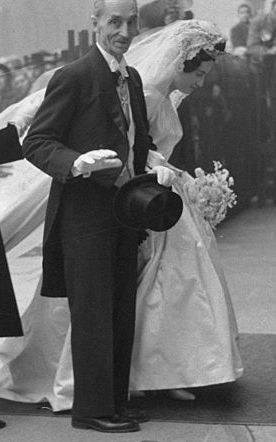
In the mid-1950s, some historians see Gambra as part of the "immovilistas," who did not want to cooperate with the Franco government. Others say he was even more against Franco than some Carlist leaders. When Carlism changed its approach to be more cooperative with Franco, Gambra stuck to his strong anti-Franco views.
Gambra was concerned about Don Javier's hesitation. He cautiously supported inviting Don Javier's son, Don Carlos Hugo, into Spanish politics. Gambra met Don Carlos Hugo in 1955 and introduced him at the 1957 Carlist gathering at Montejurra. Gambra liked Don Carlos Hugo's energetic style and his focus on loyalty to the royal family. However, by the early 1960s, Gambra realized that Don Carlos Hugo's supporters were trying to outsmart the Traditionalists. Around 1963, Gambra separated himself from Don Carlos Hugo's group and openly opposed them.
Carlism: Facing Progress
In 1963, Gambra helped create the Centro de Estudios Históricos y Políticos General Zumalacárregui. This group aimed to spread Traditionalist ideas and fight against the "progressist" (more modern) views of Don Carlos Hugo's followers. Their activities included publications and two major Traditionalist study conferences in 1964 and 1968.
As Don Carlos Hugo's supporters gained influence, Gambra tried to bring together all the Carlist groups that had separated over the past 20 years. He wanted them to unite based on their loyalty to Traditionalist principles and their opposition to socialist ideas. This plan didn't fully work until the early 1970s.
Gambra focused on refining Traditionalist ideas through specialized articles and conferences. This led to his book ¿Qué es el carlismo? (What is Carlism?, 1971), which he co-authored. In the mid-1970s, he was very involved in a propaganda war with Don Carlos Hugo's group. Gambra called on Traditionalists to challenge the progressist control over Carlism. Before the 1976 Montejurra gathering, where people were killed, he urged "true traditionalists" to attend in large numbers to oppose unacceptable ideas.
During the final years of Franco's rule and the transition to democracy, Gambra, who had always opposed Francoism, sided with the "búnker" (a term for hardline Franco supporters) when facing the changes. He spoke against the 1978 constitution and supported Blas Piñar's Fuerza Nueva party until it was dissolved in 1982.
He was saddened by the ongoing changes and tried to fight them in newspapers. He compared the situation in the late transition to the mid-1930s, when Spain was struggling with dangerous political ideas. He stayed out of active politics. When various Traditionalist groups united in 1986 to form the Comunión Tradicionalista Carlista, Gambra focused more on youth Carlist organizations, emphasizing cultural heritage and education. His goal was to promote Traditionalist values in a Spanish society that was becoming more secular and focused on consumerism.
In the late 1980s and early 1990s, Gambra was considered the top authority on Traditionalist theory. This was recognized during celebrations in his honor in 1998. In 2001, Don Sixto, a younger son of Don Javier, named Gambra as the head of his political office. Not all Traditionalists accepted this, but Gambra, at 81 years old, remained quite active. His last public appearance was in 2002.
Images for kids
See also
 In Spanish: Rafael Gambra para niños
In Spanish: Rafael Gambra para niños
- Carlism
- Traditionalism (Spain)
- Integrism (Spain)
- Francisco Elías de Tejada y Spínola
- José Miguel Gambra Gutiérrez


